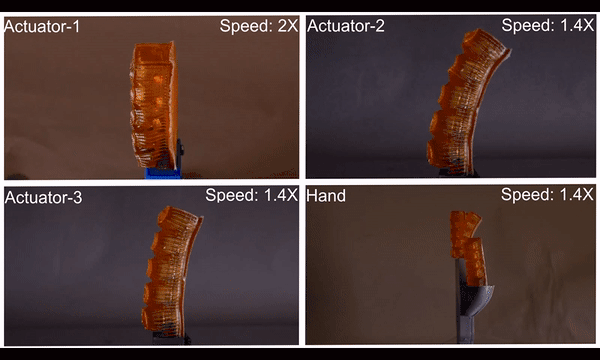This Robotic Hand Stays Cool by Sweating
The robot is three times more efficient at sweating than the animal kingdom’s best, humans and horses
/https://tf-cmsv2-smithsonianmag-media.s3.amazonaws.com/filer/84/60/84607f4d-7988-4ac6-ab4c-9a3bce593df7/2020_jan31_sweatyrobothand.jpg)
A new robotic hand has a surprisingly humanlike way to cool off: it can sweat. This isn't a traditional all-metal construction bot, in which case oozing water would probably mean something’s going wrong, or pose a threat to the electronics inside. The sweaty robot, described in a new study in Science Robotics, is made of flexible hydrogels.
Hydrogel robots, also called “soft” robots, are useful because they’re less dangerous—say, for example, a factory worker hits their head on one—compared to colliding with something made of metal. But soft robots also come with a different set of engineering challenges.
When a robot does anything that requires energy, it starts to heat up, and if it gets too hot, it will break. Metal can heat up and cool down relatively quickly. But a hydrogel, which is about 50 percent water, is more difficult to cool down once its temperature starts to rise.
Luckily, it’s a problem that had been solved before in nature. Mammals, like humans, are also largely made of water. And in our case, the solution to high temperatures is sweat.
“As is often the case, biology provided an excellent guide for us as engineers,” co-author and materials scientist TJ Wallin, who participated in the research at Cornell but now works at Facebook Reality Labs, said at a press briefing, per the Guardian’s Ian Sample. “It turns out that the ability to perspire is one of the most remarkable features of humans.”
The researchers created hydrogels with multiple layers. A balloon of water that controlled the way each finger bent was placed at the core. Then, the innermost layer was made to shrink above 86 degrees Fahrenheit. The outer layer was full of micron-sized holes that open at the same temperature. When the inner layer shrinks, it rings itself out, and the water leaks out of the micron pores.

When set in front of a fan, the sweating robot cooled off six times faster than a robot that didn’t sweat. The cooling was also three times faster than the most efficient sweating mammals: humans and horses, according to a statement.
Perspiration cools us, horses, and robots down because the liquid water in sweat needs some energy in order to evaporate and become gas. The molecules in sweat get their energy from your body heat, and vice versa—when the water evaporates, your skin temperature goes down. The researchers made their robotic skin extra-efficient by making it textured, increasing the amount of surface area that the water can draw energy from. All-in-all, "it's a really great idea," as soft robotics expert Cecilia Laschi of the BioRobotics Institute of Scuola Superiore Sant'Anna in Pisa, Italy, tells Sophie Bushwick at Scientific American.
“I think it’s a really great idea,” says Laschi, who was not involved in the new study. “One of the main contributions of this field is really to make us imagine this kind of robot with lifelike abilities, something that was not possible before, with traditional robotics technology.”
Sweat has two major downfalls for humans, though: it makes our grip slippery, and we need to constantly drink water to not become dehydrated.
The researchers at Cornell confirmed the robots gripping ability with a 3-pronged grabber—more like the claw in an arcade game than a human hand. The claw picked up hot objects and the material reacted to the high temperature by sweating—no extra sensors or electronics required, explains Wallin, per the Guardian. This version of the bot didn’t have a way to take in more water, but the researchers say that a future iteration could. Doing so would provide a natural solution to one of soft robotics' biggest hurdles, says Jonathan Rossiter, head of the soft robotics group at Bristol Robotics Laboratory, who was not invovled in the study.
“If future robots could be cooled naturally and automatically then they could perform much better in a much wider range of environments,” Rossiter tells the Guardian. “Humans can survive in the heat of the Sahara and in the freezing conditions of the Antarctic. Future robotics should be able to do the same.”